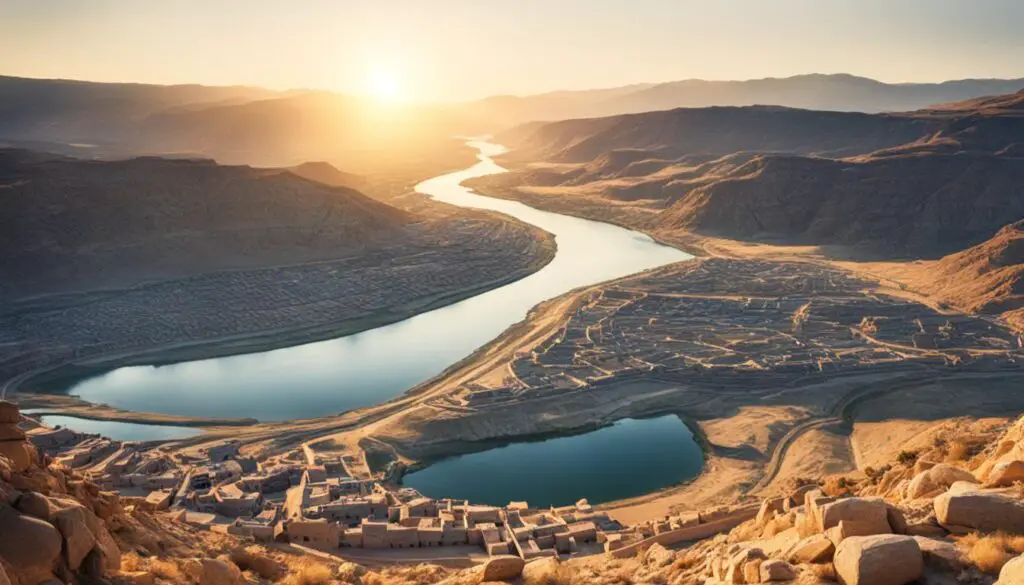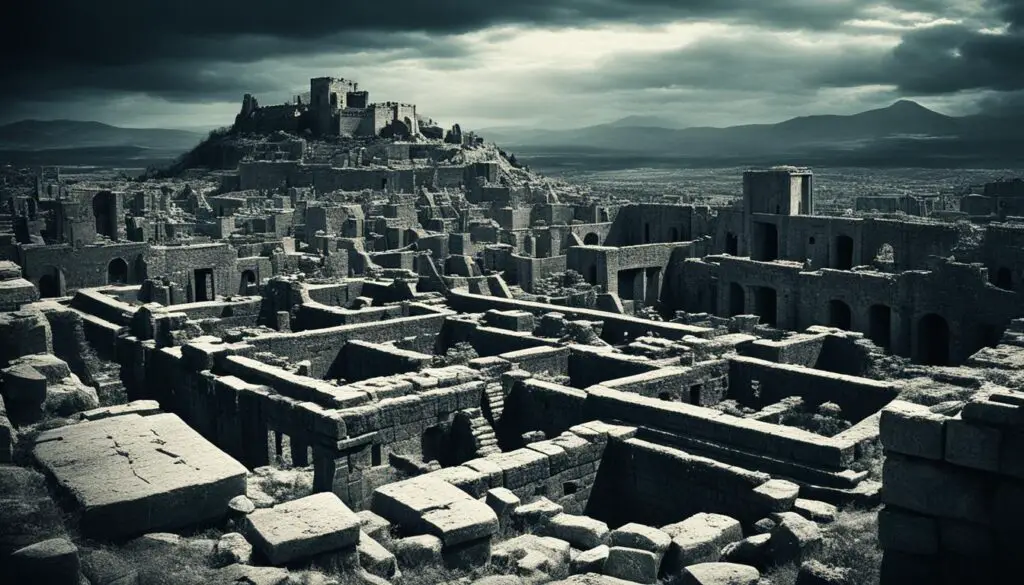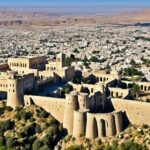Heshbon, mentioned in the Bible, is a historic city with deep roots in biblical history. It was the capital of Siḥon, the king of the Amorites, and was conquered by Moses and the Israelites. Heshbon is mentioned in various biblical passages, and its significance in the Bible is related to key events, cultural practices, and theological themes. To explore the city of Heshbon in the Bible is to delve into an important part of biblical history and gain insights into its timeless spiritual significance.
Key Takeaways:
- Heshbon is a historic city mentioned in the Bible.
- It was the capital of Siḥon and conquered by Moses and the Israelites.
- Heshbon’s significance in the Bible extends to key events and cultural practices.
- Exploring Heshbon provides insights into biblical history and theological themes.
- The city holds timeless spiritual significance in the biblical text.
Historical Significance of Heshbon
Heshbon, the capital city of Siḥon, the king of the Amorites, played a crucial role in biblical history. It holds tremendous historical significance, particularly in relation to key events in the Bible. One such event was the conquest of Heshbon by Moses and the Israelites, which marked a significant victory on their journey to the Promised Land.
Heshbon’s historical importance extends beyond its conquest. The city was also involved in conflicts with other nations, notably Moab and Ammon, as documented in the book of Judges. These conflicts highlight Heshbon’s strategic position and its significance as a political and military stronghold in the region.
Understanding the historical context of Heshbon allows us to appreciate its place in biblical narratives and gain insights into the larger scope of ancient Near Eastern history. Exploring the events that unfolded in Heshbon not only provides a glimpse into the past but also deepens our understanding of the cultural, political, and theological dynamics of that time.
“Heshbon played a pivotal role in shaping the course of biblical history, serving as a key battleground and political center in ancient times.”
To comprehend the historical significance of Heshbon, let’s take a closer look at some of the key events that took place within its walls:
Key Events in Heshbon
- The Conquest by Moses and the Israelites: The conquest of Heshbon by Moses and the Israelites marked a crucial moment in their quest for the Promised Land. This victory demonstrated the divine intervention and faith that guided the Israelites and showcased Heshbon’s importance as a regional power.
- Conflicts with Moab and Ammon: Heshbon’s involvement in conflicts with neighboring nations, such as Moab and Ammon, is mentioned in the book of Judges. These battles reflect the political tensions and power struggles that characterized the ancient Near East and shed light on the geopolitical landscape of Heshbon during that time.
These key events illustrate the historical significance of Heshbon and its role in shaping biblical history. By examining these events, we gain a deeper understanding of the dynamics and complexities of the ancient world, providing valuable insights into the cultures, ideologies, and historical context of biblical narratives.
With its rich historical background, Heshbon serves as a window into the past, allowing us to uncover the multifaceted layers of biblical history. By exploring the events and significance of Heshbon, we can develop a more comprehensive understanding of the ancient world and its enduring impact on the biblical narrative.
Geographical Location of Heshbon
Heshbon, an ancient city of great biblical significance, is situated in the geographical region known as Transjordan. This historic city is located approximately 50 miles east of Jerusalem, on the site of the present town of Ḥisbān in the southern Belka. Its strategic proximity to the Jordan River further highlights its significance in ancient times.
Heshbon’s geographical location played a crucial role in its prominence. Situated near the Jordan River, the city benefitted from its access to water resources, allowing for agricultural activities and flourishing settlements. Additionally, Heshbon’s position on the famous “King’s Highway” made it a central hub for trade and commerce, connecting various regions within the ancient Near East.
The geographical location of Heshbon in Transjordan and its proximity to the Jordan River provide valuable insights into the city’s historical development, its cultural interactions, and its significance as a crucial junction in biblical narratives.
| Geographical Features | Heshbon’s Significance |
|---|---|
| Jordan River | Strategic location for water resources, agriculture, and trade |
| “King’s Highway” | Central settlement along important trade routes |
By examining the geographical context of Heshbon, we can better understand its significance in biblical history and its interconnectedness with other cities and regions within the ancient Near East.

Archaeological Discoveries in Heshbon
The city of Heshbon has yielded fascinating archaeological discoveries through extensive excavations. In the 19th century, initial explorations uncovered the rich historical layers beneath the surface. Subsequent excavations in the late 20th century further unveiled valuable remnants of Heshbon’s past.
These meticulous excavations have brought to light the remnants dating back to the 12th-11th centuries BCE, providing valuable insights into the ancient city’s material culture, daily life, and architectural features. From pottery sherds to other intriguing artifacts, the archaeological research in Heshbon allows us to reconstruct the past and gain a deeper understanding of the city’s physical aspects that might otherwise be lost in the mists of time.
“The artifacts discovered in Heshbon provide a fascinating window into the ancient world, representing the tangible evidence of the city’s rich history and the lives of its inhabitants.”
One remarkable finding was the excavation of pottery sherds, indicating Heshbon’s significant role in ceramics production during its prime. The craftsmanship displayed in these artifacts offers a glimpse into the artistic and technical skills of the ancient inhabitants. Additionally, the discoveries of architectural features, such as walls and structures, shed light on the city’s urban layout and construction methods.
By analyzing these archaeological finds, researchers have been able to piece together a comprehensive picture of Heshbon’s past. The artifacts provide tangible evidence of the city’s past, enabling historians and archaeologists to reconstruct the cultural, social, and economic fabric of the ancient city.
Archaeological Discoveries in Heshbon:
| Discovery | Significance |
|---|---|
| Pottery Sherds | Indicate Heshbon’s involvement in ceramics production |
| Architectural Remains | Provide insights into the city’s urban layout and construction techniques |
| Artifacts from 12th-11th centuries BCE | Offer a glimpse into the material culture and daily life of Heshbon |
| Historical Layers | Reveal the city’s rich history and its importance within the region |
These archaeological discoveries continue to shape our understanding of Heshbon and its place in ancient history. They offer a tangible connection to the past and inspire us to delve deeper into the mysteries that lie beneath the surface.
Theological Themes in Heshbon
Heshbon holds great theological significance in the Bible, with its biblical references offering profound insights and spiritual lessons. The conquest of Heshbon by Moses and the Israelites exemplifies divine intervention, faith, and obedience to God’s commands. Through this event, we gain a deeper understanding of the power of trust in God and the rewards of following His guidance.
In addition to its association with the Israelites, Heshbon’s interactions with other nations bring forth moral and ethical lessons. The conflicts between Heshbon and neighboring kingdoms convey timeless messages of justice, redemption, and the consequences of disobedience. These biblical passages provide guidance on how to navigate the complexities of life and make decisions that align with God’s purposes.
“For Heshbon was the city of Sihon the king of the Amorites, who had fought against the former king of Moab and taken all his land out of his hand, as far as the Arnon.” – Numbers 21:26
By exploring the theological themes in Heshbon, we uncover the deeper spiritual significance behind its biblical mentions. We can then apply these lessons to our own lives, seeking divine wisdom and understanding as we navigate our journey of faith.
The Spiritual Significance of Heshbon
Heshbon’s spiritual significance lies in its representation of God’s sovereign rule and justice. This city serves as a reminder that God is the ultimate authority and judge, and His righteous judgment will prevail in all situations. The triumphs and trials associated with Heshbon teach us to trust in God’s plans, seek His guidance, and depend on His unfailing love and faithfulness.
“Moab is put to shame, for it is broken; wail and cry! Tell it beside the Arnon, that Moab is laid waste… In the shadow of Heshbon, the fugitives stand helpless, for fire has come out from Heshbon, flame from the house of Sihon; it has destroyed the forehead of Moab, the crown of the sons of tumult.” – Jeremiah 48:20, 45
The spiritual lessons derived from Heshbon’s biblical references encourage us to strive for righteousness, stand firm in our faith, and trust in God’s ultimate plan of redemption. Heshbon serves as a beacon of hope, reminding us of God’s faithfulness and His promise to bring justice, restoration, and victory in every circumstance.
Biblical Lessons from Heshbon
Heshbon offers a wealth of biblical lessons that guide us in our journey of faith. The conquest and fate of Heshbon illustrate the importance of obedience and the consequences of disobedience. It teaches us the power of faith and the rewards that come with trusting in God’s promises.
- Obedience to God’s commands leads to victory and blessings in our lives.
- Disobedience brings about judgment and its associated consequences.
- Faith in God’s guidance strengthens us in times of trials and challenges.
- God’s justice prevails, and the righteous are vindicated.
- God’s plan of redemption offers hope and restoration for all who believe.
Reflecting on these biblical lessons from Heshbon allows us to gain wisdom and insight into our own lives. It reminds us of the importance of aligning ourselves with God’s purposes, seeking His guidance, and living in obedience to His commands.

Exploring the theological themes in Heshbon deepens our understanding of the spiritual significance behind its biblical references. It helps us grow in our relationship with God, apply biblical principles in our lives, and find inspiration and guidance for our own journey of faith.
Key Biblical Events in Heshbon
Heshbon, mentioned in several important biblical events, holds a significant place in Israel’s history. Let’s explore its role in key biblical books.
Heshbon in the book of Numbers
In the book of Numbers, Heshbon is described as the capital city of Siḥon, the Amorite king. It was during the Israelites’ journey to the Promised Land that they encountered Siḥon and conquered Heshbon. This victory marked a crucial milestone in their quest for the land the Lord had promised them. The book of Numbers provides insights into the territorial conflicts and the divine guidance that led to the conquest of Heshbon.
Heshbon in the book of Judges
The book of Judges mentions Heshbon in the context of conflicts between Israel, Moab, and Ammon. Heshbon’s strategic location made it a focal point for territorial disputes among these nations. The book of Judges highlights the complex historical and political landscape of the time and demonstrates the evolving relationship between Heshbon and its neighboring regions. These passages offer valuable insights into the geopolitical dynamics of the period.
Heshbon in the book of Joshua
In the book of Joshua, Heshbon plays a prominent role in the division of territory among the tribes of Reuben, Gad, and Manasseh. The book records how Moses and Joshua allocated the conquered lands, ensuring each tribe received their inheritance as promised by the Lord. The geographical positioning of Heshbon made it a significant city in the division of the Promised Land, solidifying its importance in the scriptural narrative.
“And to the Reubenites, the Gadites, and the half-tribe of Manasseh Joshua said, ‘Remember the word that Moses the servant of the LORD commanded you, saying, “The LORD your God is providing you a place of rest and will give you this land.”‘ Your wives, your little ones, and your livestock shall remain in the land that Moses gave you beyond the Jordan, but all the men of valor among you shall pass over armed before your brothers and shall help them.”‘ – Joshua 1:12-14 (ESV)
Understanding the key biblical events in Heshbon allows us to trace the city’s involvement in pivotal moments of Israel’s history. It provides us with a deeper appreciation for the divine guidance, territorial disputes, and the fulfillment of God’s promises encapsulated in these biblical texts.

Stay tuned for the next section where we will explore the cultural and religious practices in Heshbon, shedding light on the daily life and belief systems of its ancient inhabitants.
Cultural and Religious Practices in Heshbon
Heshbon provides glimpses into the cultural and religious practices of ancient times. The city’s location in a fertile area made it conducive to agricultural activities, including vineyards and fields, which were integral to the daily life of its inhabitants. The proximity of Heshbon to the Jordan River and its position along trade routes contributed to its economic prosperity, fostering a vibrant city life.
Ancient Heshbon had a diverse religious landscape, with worship practices centered around various deities. The inhabitants of Heshbon would have engaged in rituals dedicated to local gods and goddesses, reflecting their belief systems and spiritual practices.
Exploring the cultural and religious practices of Heshbon allows us to gain insights into the daily lives, traditions, and belief systems of its ancient inhabitants. It provides a window into the broader context of ancient Near Eastern culture and the intertwining of religious and social dimensions.
Key Aspects of Cultural and Religious Practices in Heshbon:
| Aspect | Description |
|---|---|
| Agricultural Practices | Heshbon’s fertile lands supported extensive agricultural activities, including vineyards and fields, providing sustenance and contributing to the city’s economy. |
| Trade and Commerce | Located along trade routes and in close proximity to the Jordan River, Heshbon thrived as a center of commerce and trade, facilitating economic growth and cultural exchange. |
| Religious Worship | Ancient Heshbon encompassed a diverse religious landscape, with worship practices dedicated to various deities, reflecting the spiritual beliefs and practices of its inhabitants. |
| Social Gatherings and Festivals | The people of Heshbon likely engaged in social gatherings and celebrated festive occasions, fostering community cohesion and cultural expressions. |
The combination of agricultural abundance, trade connections, and religious practices shaped the cultural fabric of Heshbon, contributing to its uniqueness and vibrancy as an ancient city.

Prophetic and Eschatological Significance of Heshbon
Within biblical texts, the city of Heshbon possesses profound prophetic and eschatological significance. Prophetic writings, such as those found in Isaiah and Jeremiah, mention Heshbon in relation to the judgment and fate of Moab. These prophecies illuminate the symbolic value of Heshbon and its connection to broader eschatological themes, such as judgment and ultimate redemption.
Exploring the prophetic and eschatological significance of Heshbon provides invaluable insights into its role in the unfolding of God’s plan and the broader themes of biblical prophecy. It allows us to discern the intricacies of divine judgment, redemption, and the fulfillment of end-times prophecies.
Eschatological Themes in the Prophecies of Heshbon
Heshbon’s mention in the prophecies of Isaiah and Jeremiah reveals profound eschatological themes that provide hope and reassurance. These themes include:
- The ultimate triumph of righteousness over evil
- The restoration and renewal of God’s creation
- The establishment of God’s eternal kingdom
- The redemption of humankind through divine intervention
“And the fortified city will disappear from Ephraim, and dominion from Damascus, and the remnant of Aram will be like the glory of the sons of Israel,” declares the LORD of hosts. “Now in that day the glory of Jacob will fade, and the fatness of his flesh will become lean. It will be even like the reaper gathering the standing grain, as his arm harvests the ears, or it will be like one gleaning ears of grain in the valley of Rephaim.”
The Symbolism of Heshbon in End Times Prophecies
Heshbon serves as a powerful symbol in end-times prophecies, representing the judgment and ultimate redemption of nations. Its inclusion in these prophecies underscores the divine sovereignty and the fulfillment of God’s plan for the world. Through the imagery and symbolism associated with Heshbon, we gain deeper insights into the spiritual significance of biblical prophecy and its relevance to our present and future.
By exploring the prophetic and eschatological significance of Heshbon, we are compelled to contemplate the divine plan that unfolds within biblical texts. The mention of Heshbon in these prophecies reminds us of the ultimate triumph of God’s righteousness, the restoration of all things, and the fulfillment of end-times prophecies. It provides a profound message of hope and serves as a reminder of the eventual consummation of God’s redemptive work in the world.

Conclusion
In conclusion, exploring the biblical city of Heshbon reveals its profound importance in various aspects. Its historical significance is evident through its role as the capital city of Siḥon, the Amorite king conquered by Moses and the Israelites. Heshbon’s geographical location near the Jordan River and its position on the “King’s Highway” further enhances its significance.
Archaeological discoveries in Heshbon provide tangible evidence of its past, enabling us to reconstruct and understand the material culture and daily life of its ancient inhabitants. Moreover, Heshbon’s theological themes, such as divine intervention and moral lessons, offer valuable spiritual insights found within its biblical references.
Throughout the Bible, Heshbon is associated with key events, including battles and the division of territory among the tribes. Its cultural and religious practices reflect the richness of ancient Near Eastern culture. Additionally, Heshbon has prophetic and eschatological significance, symbolizing divine judgment and redemption in end times prophecies.
Overall, delving into the details of Heshbon in the Bible uncovers a wealth of knowledge and wisdom. It allows us to gain a deeper understanding of the biblical narrative and its timeless spiritual lessons. Heshbon stands as a testament to God’s providence, judgment, and redemption, resonating with believers to this day.







